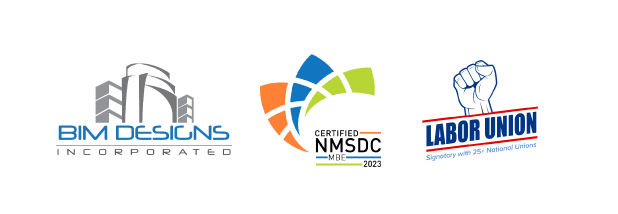
Bringing a Seasoned Contractor to BIM Designs, Inc.
Phoenix-based BIM Designs, Inc. has already been on the forefront of virtual MEP design for some time, as they expand their client-base and impact on projects across the western United States. The key to their success has been their unique combination of a young leadership team, bursting with software and tech know-how, merged with rooted construction professionals, fluent in “construction speak”. Continually growing a VDC dream-team of field-experienced MEP journeymen and engineers, they seek to also balance it with equally robust project and process managers, to deliver turnkey BIM modeling and engineering services, in an industry thirsty for innovation and efficiency.
After picking up several high-profile detailing projects in Silicon Valley, such as Google’s new campus, Google Caribbean, in Sunnyvale, CA; and YouTube’s new campus in San Bruno, CA, they began a search for a project management consultant who could help the service-provider better utilize a resource we all need more of: time. “The BIM process is all about saving money and time,” says BIM Designs CEO, Mark Oden; “therefore, we work really hard to streamline everything we do, so we can pass those savings on to our clients. To do that, we need top-notch project management.”
Now, the search is over. BIM Designs made the decision to move forward with a seasoned contractor, who not only had the level of project management experience they were looking for, but extensive personnel and team management experience, as well. They’ve welcomed Dan Vigil, a former superintendent, union president, and commissioner. Vigil has left an indelible mark on the construction industry as a contract lead, with a host of titles for Intel, Boeing, and others during his career with Hoffman General Contracting Corporation.
Question: How do you teach an old dog new tricks?
Answer: You don’t. He teaches the tricks.
Sure, Vigil brings a lot to the table with his 47 years in the trade, but a lot has changed since he started as an eager apprentice in 1971. Construction, arguably one of the oldest industries (even before you-know-what), is undergoing a disruptive, tech-driven shift, which is what makes third-party, service providers like BIM Designs possible - even necessary. Virtual teams are testing and outperforming traditional office environments, with advantages like increased productivity and overhead cost-savings. However, accountability, progress tracking, and task-management, Vigil’s specialty, never go out of style.
Vigil’s focus is on keeping things simple, as the team uses complex technology to impart design improvements on MEP projects and tackle BIM Coordination, simultaneously. By asking the seemingly benign questions: “What did you accomplish, yesterday,” “What are you doing, today,” and “What are you blocked by?”; and then, patiently jotting down answers and asking again the following day, he teaches the team to focus on the task at hand and not get bogged down by excuses or distractions that can clog progress – a process that has carried him throughout his entire career.
The “Page-Turn” Method of Task Management
In his time in the field, Vigil recalls how construction projects were refined and kept in a systematic order through tasks generated by a page-turn, a term referring to the review of a set of project drawings, one after the other, while team leads make note of individual actionable items on each page. During a page-turn, managers would ask: “How much work does the team think is needed on this page, and on what, specifically,” “Which requests for information (RFIs) need to be made,” and “Who will be the responsible party for each step?” These, along with questions on other details required for project execution, as well as for estimates and bidding, are made on each page.
“When we first began doing page-turns with Hoffman, I started assigning contractors based on an individual part of a project page, because some of these pages can get very intricate based on the type of work.”, Vigil Says. “If contractors were bidding on jobs, they’d need to know on which item, which page. So, I’d let contractors know which job was on which page, so that there’d be no ambiguity about what needed to be done.”
Discussing the efficacy of a page-turn, Vigil says, “If you’re doing a page-turn, you list all your issues, then put them in order and make sure to follow back up by closing out the issues. Making lists and execution, to Vigil, is the name of the game. And this highly-functional system is one he’s executing with great success at BIM Designs, in an effort to create a higher degree of accountability, better note-taking, and a level of organic organizational management that allows for more to be done in less time.
Learn more about Dan Vigil and his work with BIM Designs, next week.

About the Author
Steve Couch is the Head of Sales and Marketing for BIM Designs, Inc, and is based in Phoenix, AZ. He manages the marketing, sales, and estimating teams to drive revenue and expand client portfolios. An avid international traveler and award-winning public speaker, his experience in public relations, organizational leadership, project management, and communications make him a natural relationship builder, and enables him to build strong community and corporate partnerships.





